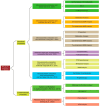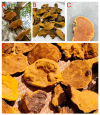Research Progress of Bioactive Components in Sanghuangporus spp
- PMID: 38542832
- PMCID: PMC10976032
- DOI: 10.3390/molecules29061195
Research Progress of Bioactive Components in Sanghuangporus spp
Abstract
The species in Sanghuangporus are a group of edible mushrooms with a long history of oral use in East Asia as a health-improvement method. They should be classified under the genus Sanghuangporus rather than mistakenly in Phellinus or Inonotus. The major components in this genus consist of polysaccharides, polyphenols, triterpenoids, and flavonoids, all of which exist in the fruiting bodies and mycelia. For extraction, studies have shown methods using hot water, ethanol, DES solvent, and alkaline, followed by purification methods including traditional anion column, Sevag solution, macroporous resin, and magnetic polymers. Proven by modern medical technology, these components possess promising anti-inflammatory, antioxidative, antitumor, and immunoregulation effects; additionally, they have health-improving effects including pulmonary protection, hypoglycemic properties, sleep improvement, gout mitigation, antiaging, neuroprotection, and muscle-strengthening abilities. Several toxicity studies have revealed their safety and recommend a dose of 1 g/kg for mice. As a newly emerged concept, functional food can provide not only life-sustaining nutrients but also some health-improving effects. In conclusion, we substantiate Sanghuang as a functional food by comprehensively presenting information on extraction and purification methods, component medical and structural properties, and nontoxicity, hoping to benefit the development of Sanghuang species as a group of functional food.
Keywords: Sanghuang; classification; effects; medical properties; polysaccharides; structure; toxicity.
Conflict of interest statement
The authors declare no conflicts of interest.
Figures




Similar articles
-
[Mycology, chemical components, bioactivities, and fermentation process regulation of Sanghuang: a review].Zhongguo Zhong Yao Za Zhi. 2024 Dec;49(24):6635-6659. doi: 10.19540/j.cnki.cjcmm.20240812.201. Zhongguo Zhong Yao Za Zhi. 2024. PMID: 39805753 Review. Chinese.
-
Comparison of Morphology, Components, and Activity of Four Species of Sanghuangporus Mushrooms (Agaricomycetes).Int J Med Mushrooms. 2025;27(7):45-65. doi: 10.1615/IntJMedMushrooms.2025058619. Int J Med Mushrooms. 2025. PMID: 40228218
-
Extraction and antioxidant activity of total triterpenoids in the mycelium of a medicinal fungus, Sanghuangporus sanghuang.Sci Rep. 2019 May 15;9(1):7418. doi: 10.1038/s41598-019-43886-0. Sci Rep. 2019. PMID: 31092852 Free PMC article.
-
Purification and antioxidant and anti-Inflammatory activity of extracellular polysaccharopeptide from sanghuang mushroom, Sanghuangporus lonicericola.J Sci Food Agric. 2021 Feb;101(3):1009-1020. doi: 10.1002/jsfa.10709. Epub 2020 Aug 26. J Sci Food Agric. 2021. PMID: 32767366
-
Structural diversity and bioactivity of polysaccharides from medicinal mushroom Phellinus spp.: A review.Food Chem. 2022 Dec 15;397:133731. doi: 10.1016/j.foodchem.2022.133731. Epub 2022 Jul 18. Food Chem. 2022. PMID: 35908464 Review.
Cited by
-
A conserved terpene cyclase gene in Sanghuangporus for abscisic acid-related sesquiterpenoid biosynthesis.BMC Genomics. 2025 Apr 15;26(1):378. doi: 10.1186/s12864-025-11542-9. BMC Genomics. 2025. PMID: 40234762 Free PMC article.
-
Isolation and Antioxidant Mechanism of Polyphenols from Sanghuangporous vaninii.Antioxidants (Basel). 2024 Dec 5;13(12):1487. doi: 10.3390/antiox13121487. Antioxidants (Basel). 2024. PMID: 39765816 Free PMC article.
-
From Logs to Bags: A Metabolic Blueprint of Sanghuang Cultivation Revealed by UPLC-Q-TOF-MS/MS and Amino Acid Profiling.Molecules. 2025 Jul 1;30(13):2829. doi: 10.3390/molecules30132829. Molecules. 2025. PMID: 40649343 Free PMC article.
-
A Comprehensive Review of the Diversity of Fungal Secondary Metabolites and Their Emerging Applications in Healthcare and Environment.Mycobiology. 2024 Dec 3;52(6):335-387. doi: 10.1080/12298093.2024.2416736. eCollection 2024. Mycobiology. 2024. PMID: 39845176 Free PMC article. Review.
-
UPLC-MS metabolite profiling and antioxidant activity of Sanghuangporus sanghuang extract.PeerJ. 2025 Jan 22;13:e18758. doi: 10.7717/peerj.18758. eCollection 2025. PeerJ. 2025. PMID: 39866569 Free PMC article.
References
-
- Li I.C., Chang F.C., Kuo C.C., Chu H.T., Li T.J., Chen C.C. Pilot Study: Nutritional and Preclinical Safety Investigation of Fermented Hispidin-Enriched Sanghuangporus sanghuang Mycelia: A Promising Functional Food Material to Improve Sleep. Front. Nutr. 2021;8:788965. doi: 10.3389/fnut.2021.788965. - DOI - PMC - PubMed
Publication types
MeSH terms
Substances
LinkOut - more resources
Full Text Sources
Other Literature Sources
Research Materials
Miscellaneous

